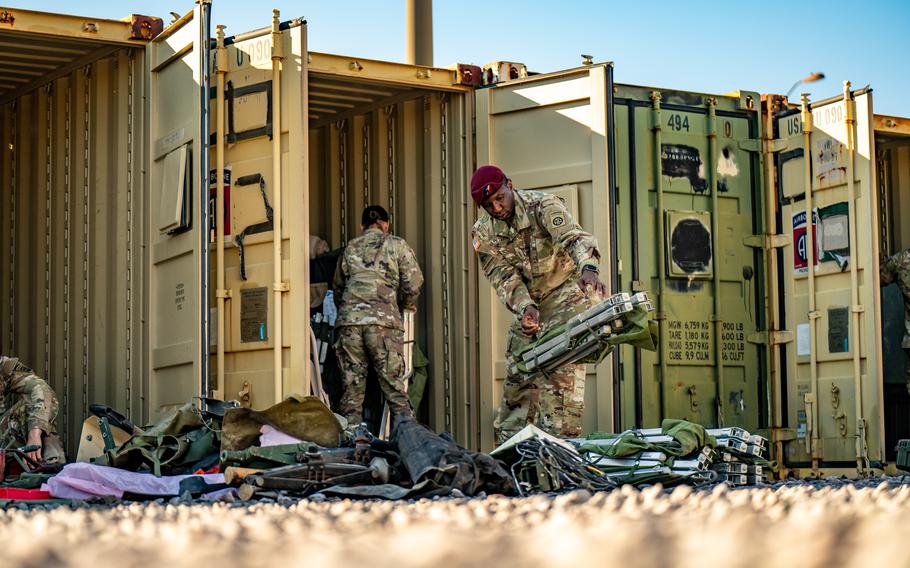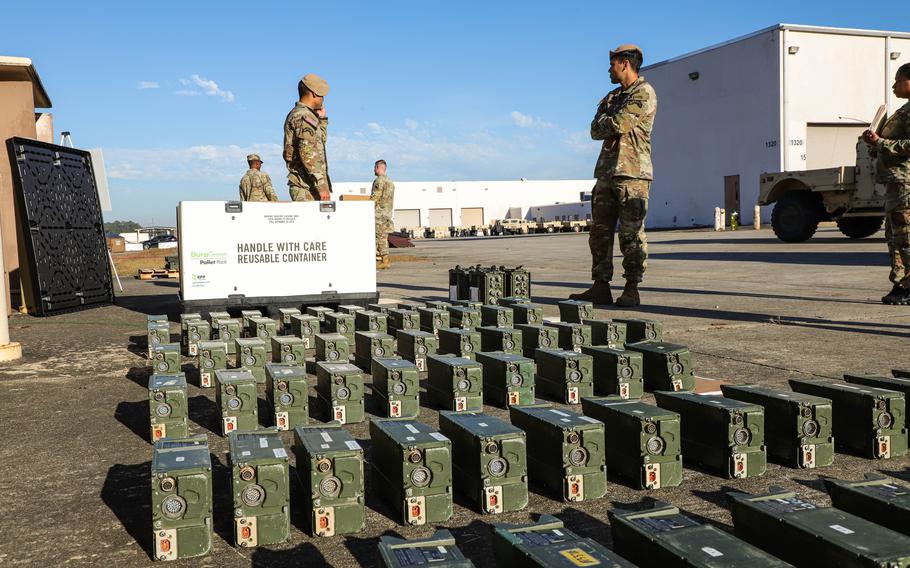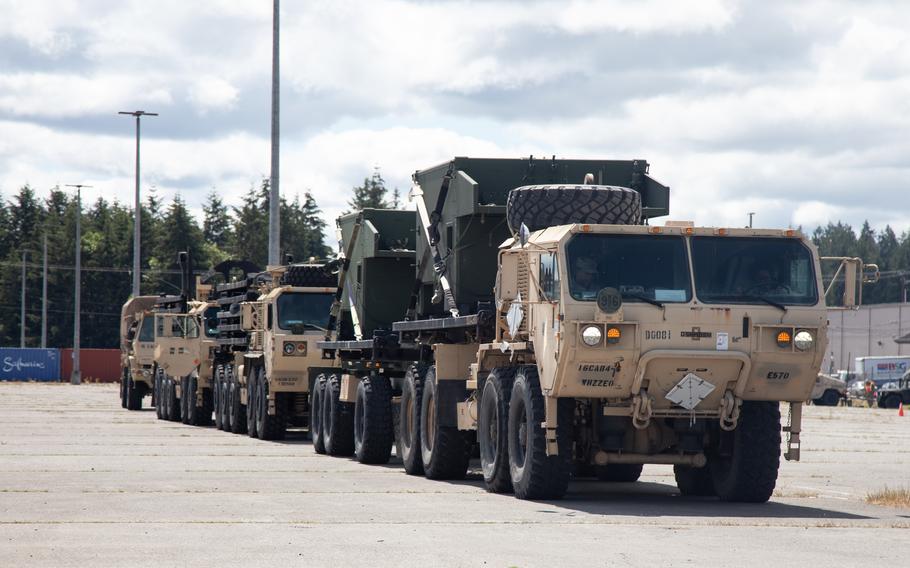
The 82nd Special Troops Battalion along with the 82nd Airborne Division Sustainment Brigade prepare equipment for the Rapid Removal of Excess Program at Fort Liberty, N.C., in October 2023. Units will relinquish outdated and excess equipment to align with the Army’s vision of keeping brigades light and more lethal. (Vincent Levelev/U.S. Army)
JOINT BASE LEWIS-MCCHORD, Wash. — One of the largest military bases in the U.S. is conducting a massive housecleaning of redundant and outdated military gear and hardware.
Old Humvees and field radios, older M-16 rifles, trucks and ammunition boxes, camouflage netting, generators, computers, outdated nuclear-biological-chemical protection gear, light tactical vehicles, towed trailers, and older night vision goggles are all on the list for removal at Joint Base Lewis-McChord, Wash.
The plan is to pick it up and move it out to units that can still use the gear. Called Rapid Removal of Excess, or R2E, the collection of weapons, materials and equipment aims to streamline and modernize Army units.
The R2E program has already been completed for XVIII Airborne Corps at Fort Stewart, Ga., Fort Liberty, N.C., and the 101st Airborne Division at Fort Campbell, Ky. After I Corps and Lewis-McChord, the Army wants to take the program to III Corps at Fort Cavazos, Texas.
Since the cleanup began at Lewis-McChord, 44,000 soldiers including I Corps, the 7th Division, and a collection of tenant units, including Special Forces detachments at the Pacific Northwest base, have turned in a growing cache of materials.
To date, more than 33,000 pieces of equipment worth an estimated $418 million have been processed through the program. The final total could reach 60,000 items when the program is completed later in the summer.

Soldiers with the 1st Ranger Battalion, 3rd Infantry Division, inspect their radios during the Rapid Removal of Excess Program at Fort Stewart, Ga., in November 2023. The Army is moving into a new era and by getting rid of excess equipment, the service is creating space for more modernized weapons, according to Gen. Randy George, the service chief of staff. (Rebeca Soria/U.S. Army)
Col. Jamison Smith, the support operations officer for the 593rd Expeditionary Sustainment Command at the base, said the goal is to be lighter and less encumbered while using the best equipment available.
As U.S. military strategy shifts more emphasis to the Indo-Pacific region to check China’s expansion and influence, units would be asked to fight in larger formations over longer distances than in the operations against terrorists in the Middle East and Africa.
“The end state the Army wants is more agile units, ready to answer the call when they are told to go, with the equipment they need for a “near-peer” fight that will require them to move constantly and stay more static,” Smith said.
Capt. Colin Wiener, commander of the 16th Combat Aviation Brigade, said the troops appreciate getting rid of obsolete equipment.
“I’m very pleased with this — it took four pages off our property books, saved days of inventorying what we don’t use, saves time — soldiers time that can be used for training,” he said. “And it saves the Army a ton of money by not having to maintain things we don’t use anymore and getting them where they are wanted.”
Gen. Randy George, the Army chief of staff, directed the Army Materiel Command to develop a pilot program to find and reduce surplus equipment and move it to units that can put it to use.
Warrant Officer Nicolas Fajardo, the 16th CAB’s property book officer, said the program will get surplus moved up and out from where it has sat unused, in some cases, for years.
“The idea is not about getting rid of accountability,” he said. “Property does not grow legs and run away. It sits and takes away space and time.”
As the Army’s command for the increasingly crucial Indo-Pacific region, I Corps was one of the early adopters of a plan that will extend across the service.
Two key actions were taken ahead of the mass turn-in to spur the work.
Commanders laid out a specific window in the spring for cataloging and removing the equipment instead of an ongoing process that could allow other priorities to delay it throughout the year.

Military vehicles from the 16th Combat Aviation Brigade, 7th Infantry Division, are staged in a line before undergoing the Army’s Rapid Removal of Excess program at Joint Base Lewis-McChord, Wash., on June 18, 2024. The program allows units to receive immediate property accountability relief for excess equipment, enabling them to focus on new equipment fielding without the burden of obsolete material. (Effie Mahugh/U.S. Army)
The program also shifted the responsibility for ensuring the equipment meets Army standards from units that have the equipment and don’t want it to units that want the equipment and don’t have it.
Previously, the units with the surplus materials had to ensure the equipment met the Army standard of cleanliness and repair, with missing parts requisitioned and restored before handing it over for transfer.
Under the R2E program, that job shifts to the receiving units. The material is shipped with less maintenance and sent to its next location as is. It’s up to the units that want the equipment to then do the work to make the weapons, gear, and equipment mission-capable. The receiving units are aided by the Materiel Command.
Other equipment could go to the Defense Logistics Agency for distribution, sent to overseas allies, or declared surplus and sold or donated to the public.
Lightening the bureaucratic load while eliminating equipment from before they were born is satisfying for soldiers.
“The Army is saying, let’s update everything we can, get rid of the old, and get you the new,” said Sgt. Diva Arauz, whose property book with the 16th Combat Aviation Brigade at Lewis-McChord has become noticeably lighter. “Really, some of this stuff hasn’t been used since Vietnam.”